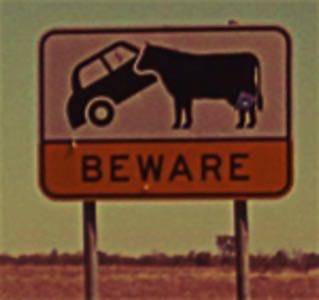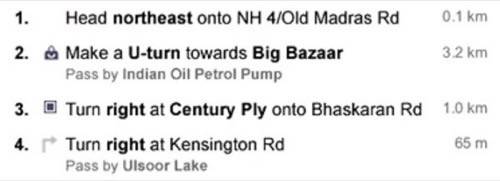You’d think it was odd if you called me for directions and I told you to go 0.2 miles southeast and make a slight right onto Old Route 17.

You’d expect me to say something more like, “Start driving away from the library and take the second right just after the McDonald’s.” Google Maps India has just launched a hybridized version of directions that give geographically accurate distances and directions as well as landmarks most humans would also recognize. We can imagine this coming to the rural U.S. and Google telling us to “follow that-there little jog in the road where the big oak tree used to be before Jimmy Ray hit it with his daddy’s combine, bless his heart, for 2.3 miles.”
Although most urban Americans are comfortable navigating by street signs, in other parts of our country and the rest of the world, landmarks are a necessity to successfully reaching one’s destination. Other times, it’s simply reassuring to know that you haven’t actually missed a turn or your destination because you haven’t yet passed a given landmark.
How many times has someone told you on the phone to “keep going straight until you pass the shopping center” or something of that sort, and it saved you a missed turn as well as a general sense of anxiety? In the words of UX Googler Olga Khroustaleva, “We found that using landmarks in directions helps for two simple reasons: they are easier to see than street signs and they are easier to remember than street names… Sometimes there are simply too many signs to look at, and the street sign drowns in the visual noise. A good landmark always stands out.”
The point of the whole experiment was to give drivers a sense of confidence when exploring new territory. Ultimately, the Google team found that a combination of street names and distances as well as landmarks gave the best results and best satisfied users.
Sree Unnikrishnan and Manik Gupta wrote on the Google India blog, “This effort was possible thanks to the large amount of landmark data that users like you contributed through Google Map Maker. Our new algorithm determines from available signals, which of these landmarks are most useful for navigation, based on importance and closeness to the turns that you’re making.”
Here’s a look at the Google Maps directions design we all know:

And here’s a version Google Maps India tried that added landmarks to other data to confirm directions:

Finally, here’s what Indian travellers will see moving forward:

Looks pretty sweet to us! What do you folks think? Would you like to see more Map Maker landmark data for driving directions all over the world, too? Let us know in the comments.










